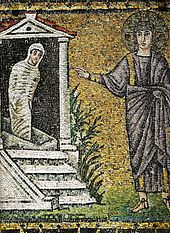Raising of Lazarus

The Raising of Lazarus or the Resurrection of Lazarus, mentioned only in the Gospel of John (John 11:1-44), is a miracle of Jesus in which Jesus brings Lazarus of Bethany back to life four days after his burial.[1][2] According to American theologian J P Dabney, "the usual reason assigned for the omission of so remarkable a story, as that of the resurrection of Lazarus by the other three Ev[angelists], is that he might still be living, when they wrote, and that a circumstantial account of this event, would have exposed him to the resentment of the unbelieving Jews, but John's G[ospel] was later by many years: in which long interval Lazarus' death was not unlikely to have occurred".[3]
Bible narrative
According to John 11:1-44, Jesus is informed by messengers that Lazarus is ill, and his two sisters are seeking his help. Jesus tells his followers that he intends to wait for Lazarus to die, in order that God may be glorified:
"This sickness will not end in death. No, it is for God's glory so that God's Son may be glorified through it."
Jesus then delays for two days. The disciples are afraid of returning to Judea, but Jesus commands them to go with him, stating:
"Lazarus is dead, and for your sake I am glad I was not there, so that you may believe."
When they arrive in Bethany, Lazarus has been dead and buried for four days. Before they enter the town, Martha, Lazarus' sister, comes to meet Jesus and tells him: "if you had been here, my brother would not have died". Jesus assures Martha that her brother will rise again and states:
"I am the resurrection and the life. He who believes in me will live, even though he dies; and whoever lives and believes in me will never die. Do you believe this?"
Martha's affirmation that she does indeed believe, "Yes, Lord. I believe that you are the Messiah, the Son of God, who is to come into the world", is only the second time (after Nathanael) that someone declares Jesus as Son of God and the first time someone equates him as 'Messiah' and 'Son of God' together. The only other time this happens in the entire gospel is in the explanation the author of the Gospel gives for writing his Gospel as the very end.

Upon entering the village, Jesus is met by Mary and the Jewish people with her. Upon seeing their grief and weeping, Jesus is deeply moved. Then, after asking where he was buried, the shortest verse in the four Gospels is found - Jesus wept. After that, Jesus asks for the stone of the grave to be removed, but Mary interjects that there will be a smell. To which Jesus responds,
"Did I not tell you that if you believed, you would see the glory of God?"
So they took away the stone. Then Jesus looked up and said:
"Father, I thank you that you have heard me. I knew that you always hear me, but I said this for the benefit of the people standing here, that they may believe that you sent me."
When he had said this, Jesus called in a loud voice, "Lazarus, come out!" The dead man came out, his hands and feet wrapped with strips of linen, and a cloth around his face. Jesus said to them, "Take off the grave clothes and let him go."
The miracle of the raising of Lazarus is the climax of John's "signs". It explains the crowds seeking Jesus on Palm Sunday, and leads directly to the decision of Caiaphas and the Sanhedrin to plan to kill Jesus. Theologians Moloney and Harrington view the raising of Lazarus as a "pivotal miracle" which starts the chain of events that leads to the Crucifixion of Jesus. They consider it as a "resurrection that will lead to death", in that the raising of Lazarus will lead to the death of Jesus, the Son of God, in Jerusalem which will reveal the Glory of God.[4]
See also
References
- ^ "John 11:1-46". Biblegateway. NIV.
- ^ Clowes, John (1817). The Miracles of Jesus Christ. Manchester, UK: J. p. 274.
- ^ Dabney, J. P. (1829), Annotations on the New Testament, accessed 29 May 2016
- ^ Francis J. Moloney, Daniel J. Harrington, 1998 The Gospel of John Liturgical Press ISBN 0-8146-5806-7 page 325

